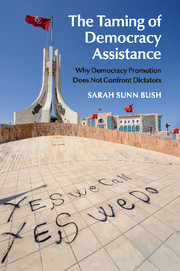Book contents
- Frontmatter
- Contents
- List of figures
- List of tables
- Preface
- List of abbreviations
- Part I Introduction and argument
- 1 Introduction
- 2 The argument: structure, agency, and democracy promotion
- 3 Tame democracy assistance: what it is and why it matters
- Part II Testing the argument
- Part III Conclusions
- Part IV Appendices and references
3 - Tame democracy assistance: what it is and why it matters
from Part I - Introduction and argument
Published online by Cambridge University Press: 05 May 2015
- Frontmatter
- Contents
- List of figures
- List of tables
- Preface
- List of abbreviations
- Part I Introduction and argument
- 1 Introduction
- 2 The argument: structure, agency, and democracy promotion
- 3 Tame democracy assistance: what it is and why it matters
- Part II Testing the argument
- Part III Conclusions
- Part IV Appendices and references
Summary
US democracy assistance has “high” and “low policy” elements. High policy is reflected in the actions senior US officials take vis-à-vis other governments … “Low policy” is much quieter and less visible, and resides mostly in the democracy-assistance programmes that operate day-in, day-out, in close to 100 countries.
In the twenty-first century, the United States government has supported many activities in Jordan under the umbrella of advancing democracy. One USAID-sponsored program purchased an electronic voting system for the national parliament in the hopes of fostering transparency and accountability there. Another program, run by NDI, sought to increase women's representation by training over fifty female candidates for an upcoming parliamentary election. Meanwhile, the International Republic Institute (IRI) trained opposition political parties, such as the Al Wasat Islamic Party, on effective platforms and messages. Finally, the Solidarity Center supported union activists that were organizing migrant workers to fight for better working conditions and wages in Jordan's qualified industrial zones, where goods produced in collaboration with Israel benefited from a free trade agreement with the United States.
Although those programs all explicitly claimed to promote democracy in Jordan, only some were designed to challenge Jordan's King Abdullah. The Jordanian legislature, for example, is a favorite institution of the monarchy, which uses the parliament as a means to distribute patronage to supporters; it is not an engine of democratization but instead a tool of autocratic survival. NDI's effort to increase women's representation thus took place within a regime-sanctioned institution and played into the regime's strategy of impressing foreign donors with a progressive record (for the region) on gender. Meanwhile, and as I will discuss I in more detail in Chapter 7, there is little evidence that the female participants in such programs used their new positions to press for change. Elsewhere, USAID's electronic voting system collected dust – especially during the lengthy periods when the king dismissed parliament at will. As such, it did little to destabilize liberal authoritarianism in Jordan.
- Type
- Chapter
- Information
- The Taming of Democracy AssistanceWhy Democracy Promotion Does Not Confront Dictators, pp. 53 - 76Publisher: Cambridge University PressPrint publication year: 2015

